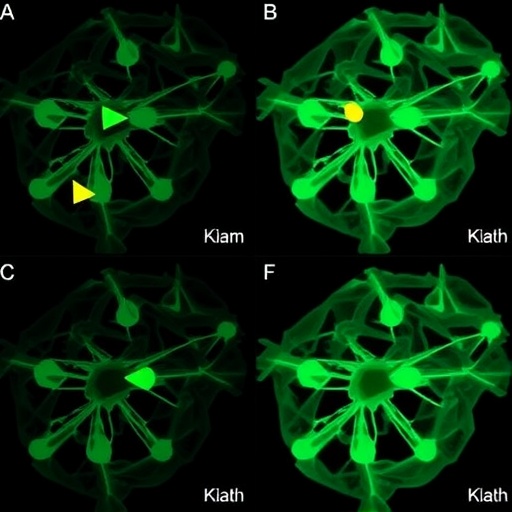In a groundbreaking development poised to reshape oncological care, researchers have unveiled a sophisticated machine learning model capable of predicting hematologic toxicity (HT) in patients with advanced cervical cancer undergoing chemoradiotherapy. By harnessing the power of interpretable artificial intelligence and integrating multifaceted radiomic and dosimetric data, this novel approach promises to enhance clinical decision-making and improve treatment outcomes significantly.
Hematologic toxicity, a prevalent and severe side effect of chemoradiotherapy in cervical cancer, often manifests as a detrimental impairment of bone marrow function, leading to complications such as anemia, leukopenia, and thrombocytopenia. Accurate prediction of HT remains a formidable challenge in clinical oncology due to the multifactorial nature of toxicity development and individual patient variability. Addressing this gap, the recent study leverages large-scale radiomic and dosimetric feature extraction coupled with advanced machine learning techniques to forecast HT risk with unprecedented precision.
The research team retrospectively analyzed clinical data, planning computed tomography (CT) images, and corresponding dose distributions from a cohort of 205 advanced cervical cancer patients treated with chemoradiotherapy. Their methodology entailed segmenting regions of interest within CT scans and extracting high-dimensional radiomic features—quantitative imaging biomarkers capturing tumor and tissue heterogeneity patterns. Concurrently, dosiomics features representing spatial dose distribution characteristics were computed from the treatment plan’s dose files to reflect radiation exposure intricacies.
Feature selection was meticulously conducted using a random forest algorithm, enabling the identification of the most informative parameters from the extensive radiomic and dosiomic feature pool. Subsequently, three distinct predictive models were constructed utilizing extreme gradient boosting trees: one based solely on radiomics, another derived from dosiomics, and a hybrid model that integrated features from both domains. This comparative design permitted a robust evaluation of individual and combined data modalities in predicting HT.
Performance metrics underscored the superiority of the hybrid model, achieving a sensitivity of 0.50, specificity of 0.83, and an area under the receiver operating characteristic curve (AUC) of 0.83. These figures notably outperformed the radiomics model (sensitivity 0.42, specificity 0.86, AUC 0.78) and the dosiomics model (sensitivity 0.50, specificity 0.90, AUC 0.74), underscoring the synergistic value of integrating imaging and dosimetric data. This enhancement in classification capability offers clinicians a robust tool for early identification of patients at elevated risk for hematologic complications.
A distinctive feature of this research lies in its commitment to model interpretability—a critical consideration often overlooked in AI applications in healthcare. The team employed SHapley Additive exPlanations (SHAP) values to dissect and elucidate the inner workings of the hybrid model. This interpretability framework enabled visualization of the relative importance of each feature, quantified their individual effects on risk prediction, and revealed complex interactions underlying the algorithm’s decision-making process.
By providing transparent insights into the predictive features, SHAP analysis empowers clinicians to understand the rationale behind the model’s assessments, fostering trust and facilitating clinical integration. For instance, the interpretability plot highlighted specific radiomic texture features and dosimetric parameters that substantially influence HT risk, guiding oncologists toward more personalized treatment modifications and vigilant monitoring plans.
This study’s methodological rigor and clinical relevance mark a significant advance in precision oncology. It exemplifies the convergence of cutting-edge medical imaging, computational analytics, and artificial intelligence to tackle a pressing clinical challenge. Furthermore, it paves the way for the adoption of similar interpretable machine learning frameworks across diverse cancer types and therapeutic contexts.
Nevertheless, the researchers acknowledge certain limitations, including the retrospective nature of the data and the necessity for external validation in multi-institutional cohorts to reinforce the model’s generalizability. Prospective studies incorporating longitudinal patient monitoring and integration of genomic or proteomic markers may further refine predictive accuracy and clinical applicability.
The implications of this work extend beyond toxicity prediction, raising intriguing possibilities about dynamic treatment adaptation. With reliable forecasts of adverse effects, clinicians can modify radiation doses, chemotherapy regimens, or supportive care interventions in real time, potentially mitigating complications while maintaining oncologic efficacy.
Moreover, the introduction of interpretable AI models addresses the ethical and practical imperatives in medicine by ensuring that machine-driven recommendations are comprehensible and justifiable. This alignment promotes responsible AI deployment and fosters multidisciplinary collaboration among radiologists, oncologists, data scientists, and patients.
As cervical cancer remains a leading cause of cancer mortality in women worldwide, advancements like these offer a beacon of hope. Personalized risk stratification and toxicity prevention can dramatically improve quality of life and survival rates, especially in resource-constrained settings where treatment tolerability is paramount.
In conclusion, this pioneering research elegantly demonstrates that the integration of radiomics and dosiomics within explainable machine learning models holds significant promise for predicting hematologic toxicity in advanced cervical cancer patients. Such innovations herald a new era of patient-centric, data-driven oncology, in which treatment decisions are finely tuned to individual biological and treatment-related nuances.
The future of cancer therapy is increasingly intertwined with artificial intelligence, but as this study highlights, the key to transformative impact lies in melding powerful computational tools with transparent, clinically meaningful insights. Through this synergy, the vision of truly personalized, safer cancer care moves ever closer to reality.
Subject of Research: Predictive modeling of hematologic toxicity in advanced cervical cancer patients undergoing chemoradiotherapy using radiomic and dosiomic data integrated through interpretable machine learning.
Article Title: Predicting hematologic toxicity in advanced cervical cancer patients using interpretable machine learning models based on radiomics and dosimetrics.
Article References:
Zhu, J., Zhou, Q., Chen, L. et al. Predicting hematologic toxicity in advanced cervical cancer patients using interpretable machine learning models based on radiomics and dosimetrics. BMC Cancer 25, 1516 (2025). https://doi.org/10.1186/s12885-025-14999-9
Image Credits: Scienmag.com




